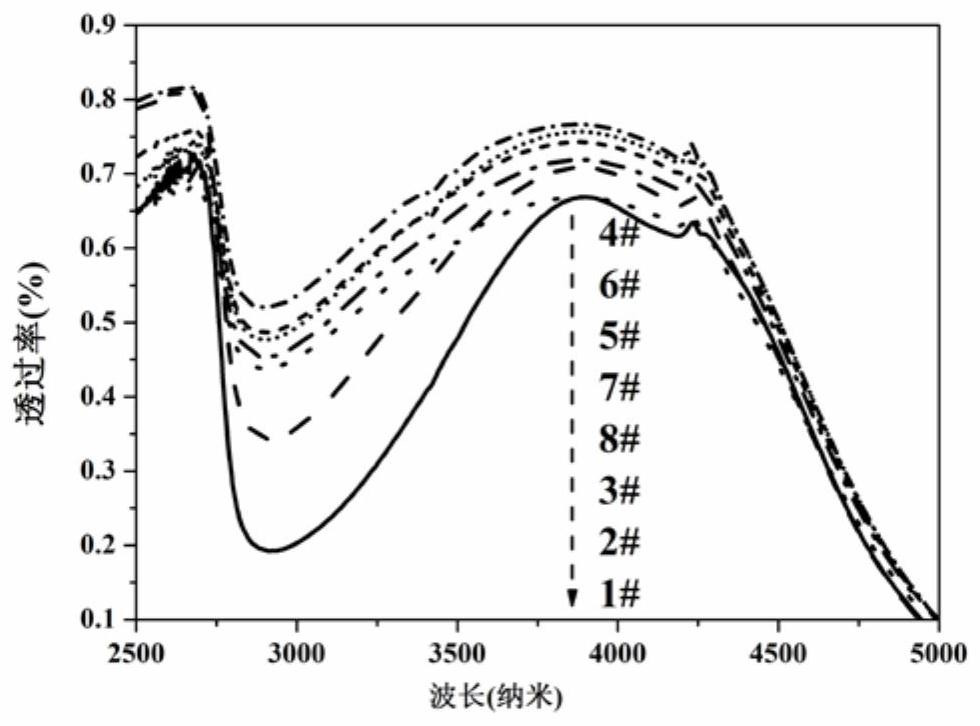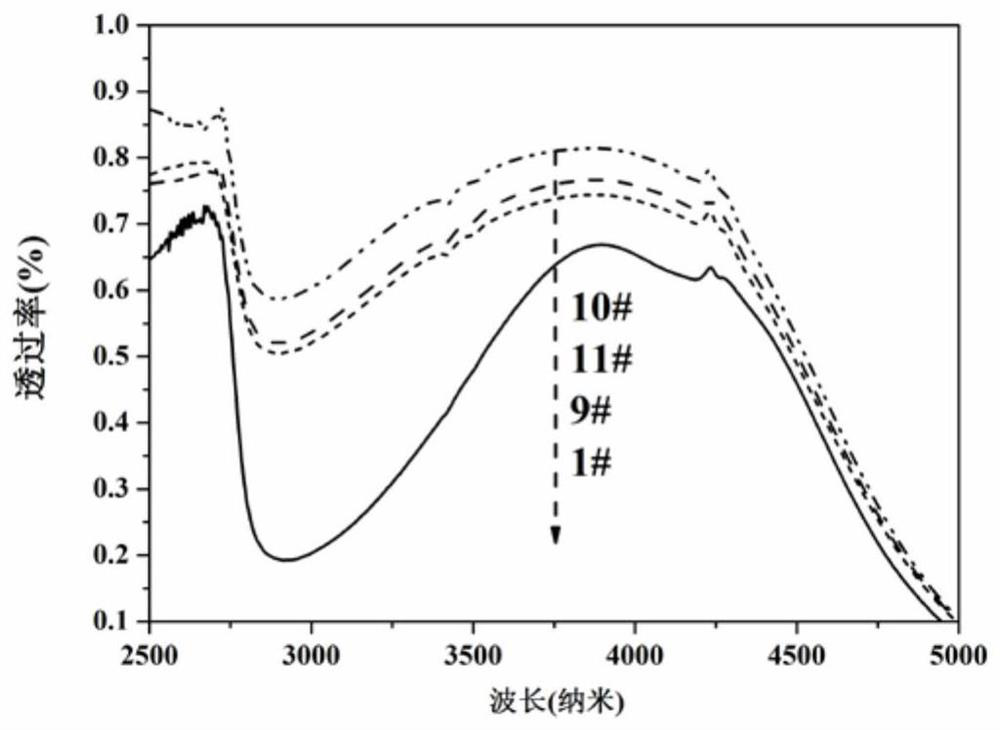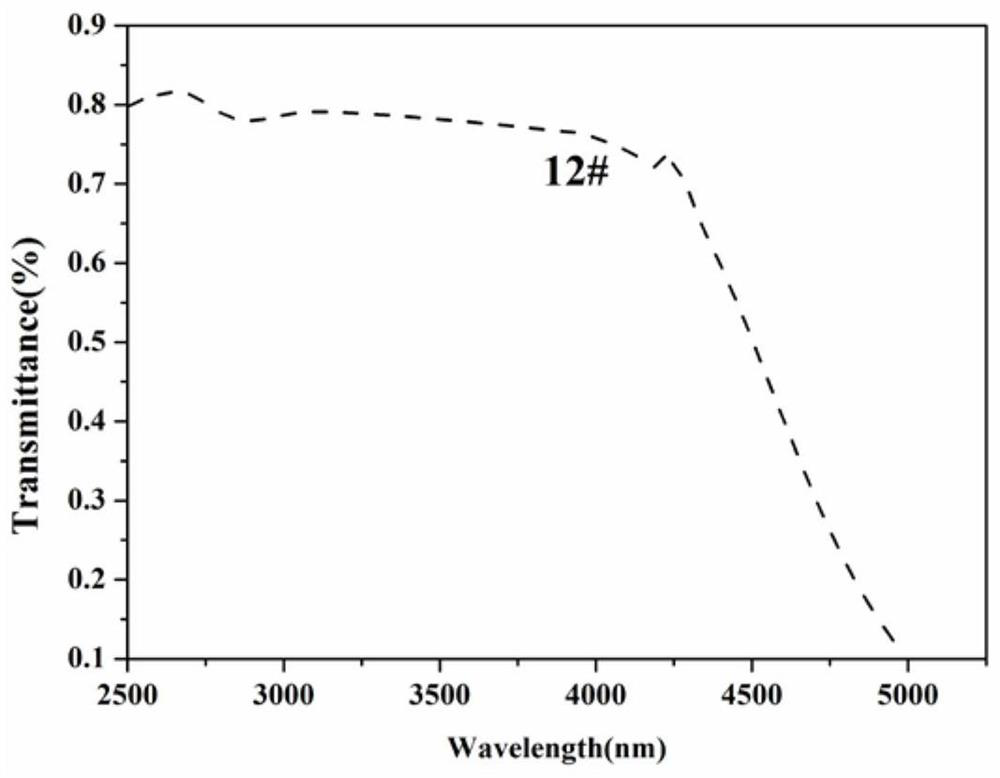A kind of germanosilicate glass and preparation method thereof
A germanosilicate and glass technology, applied in glass manufacturing equipment, glass molding, manufacturing tools, etc., can solve the problems of low glass transition temperature, low water resistance and mechanical strength, and achieve reduced hydroxyl absorption coefficient, low hydroxyl coefficient, the effect of good infrared transmission performance
- Summary
- Abstract
- Description
- Claims
- Application Information
AI Technical Summary
Problems solved by technology
Method used
Image
Examples
Embodiment 1
[0021] The germanosilicate glass of this embodiment includes 8 cases, and the molar percentages of the compositions are shown in Table 1 as 1#, 2#, 3#, 4#, 5#, 6#, 7#, and 8#.
[0022] Table 1: Glass formulations for 8 specific cases.
[0023]
[0024] The germanosilicate glass shown as 1#, 2#, 3#, 4#, 5#, 6#, 7#, 8# in Table 1, the preparation process is as follows: according to 1#, 2# in Table 1, 3#, 4#, 5#, 6#, 7#, the molar percentage of 8# glass composition, calculate the corresponding weight of each composition, weigh each raw material and mix evenly; Melt in a silicon carbide rod electric furnace at ℃, clarify for 15 minutes after complete melting, and pour the molten glass into a preheated mold; quickly move the glass into a muffle furnace that has been heated to a specific annealing temperature, keep it warm for 4 hours, and then heat it for 10 The rate of °C / hour was lowered to room temperature, and the glass sample was taken out after complete cooling.
[0025]...
Embodiment 2
[0027] The germanosilicate glass of this embodiment includes 4 cases, and the molar percentages of the compositions are shown in Table 1 as 1#, 9#, 10#, and 11#.
[0028] Table 2: Glass formulations for 4 specific cases.
[0029]
[0030] As shown in Table 2 1#, 9#, 10#, 11#, the specific preparation process is as follows: according to the mole percentage of 1#, 9#, 10#, 11# glass composition in Table 2, Calculate the corresponding weight of each component, weigh each raw material and mix evenly; put the mixture into a platinum crucible and melt it in a silicon carbide rod electric furnace at 1550 ° C, and clarify it for 15 minutes after complete melting, pour the molten glass into a preheated quickly move the glass into a muffle furnace that has been heated to a specific annealing temperature, keep it warm for 4 hours, then lower it to room temperature at a rate of 10°C / hour, and take out the glass sample after complete cooling.
[0031] The test results of the glass are ...
Embodiment 3
[0033] germanosilicate glass, on SiO 2 -GeO 2 -BaO-Ga 2 o 3 Add fluoride, halide and oxide to the glass system to form 12#: 30SiO 2 -35GeO 2 -10Ga 2 o 3 -5BaF 2 -5BaCl 2 -10 Lu 2 o 3 -5ZrF 4 ;
[0034] The preparation process is as follows: according to the molar percentage of the 12# glass composition, calculate the corresponding weight of each composition, weigh each raw material and mix them evenly; put the mixture into a platinum crucible and melt it in a carbon rod electric furnace at 1500°C. After clarifying for 15 minutes, pour the molten glass into a preheated mold; quickly move the glass into a muffle furnace that has been heated to a specific annealing temperature, keep it warm for 4 hours, and then lower it to room temperature at a rate of 10°C / hour. After cooling completely Remove the glass sample.
[0035] The test results of the glass are as follows: the annealed sample is processed into 10 × 20 × 1.0mm 3 The glass piece was polished and tested for ...
PUM
 Login to View More
Login to View More Abstract
Description
Claims
Application Information
 Login to View More
Login to View More - R&D
- Intellectual Property
- Life Sciences
- Materials
- Tech Scout
- Unparalleled Data Quality
- Higher Quality Content
- 60% Fewer Hallucinations
Browse by: Latest US Patents, China's latest patents, Technical Efficacy Thesaurus, Application Domain, Technology Topic, Popular Technical Reports.
© 2025 PatSnap. All rights reserved.Legal|Privacy policy|Modern Slavery Act Transparency Statement|Sitemap|About US| Contact US: help@patsnap.com



